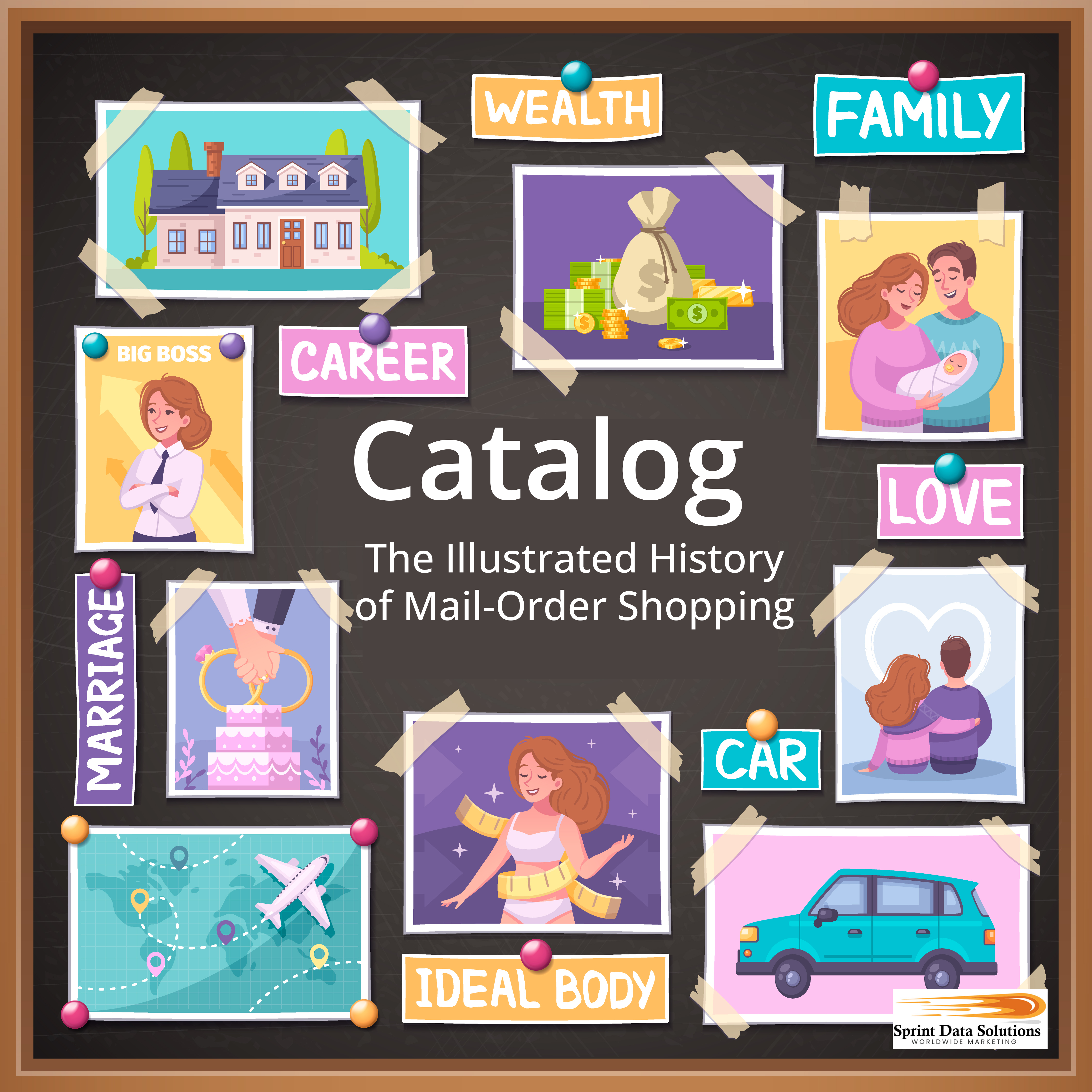Catalog & Magazine Mailing List
The 21st century has ushered in dramatic transformations in the way traditional activities are carried out, especially in the realm of shopping. Once a routine involving visits to physical stores—ranging from local markets to sprawling shopping malls—shopping has evolved into a seamless digital experience for many Americans. With the rise of e-commerce platforms and mobile apps, consumers now enjoy the convenience of browsing and purchasing products anytime and anywhere. Yet, in an unexpected but insightful development, one of the oldest methods of retail promotion—the catalog—continues to hold its ground even in this highly digital landscape.
Historically, catalogs represented a pivotal touchpoint between businesses and consumers, allowing people to explore products from the comfort of their homes long before the internet era. Today, their influence persists, not just in print form but increasingly in digital iterations such as online brochures and interactive PDF guides. These materials still appeal to specific demographics who value the tactile engagement of flipping through pages or who prefer curated selections over endless digital scrolls. Furthermore, catalogs have laid the groundwork for the structured organization of modern e-commerce websites, influencing how online stores categorize and present products.
Catalogs and magazines, whether printed or digital, continue to play a vital role in multi-channel marketing strategies. They offer targeted outreach opportunities and drive engagement by blending traditional trust with modern accessibility. For businesses aiming to tap into this enduring marketing avenue, Sprint Data Solutions Worldwide Marketing provides expert solutions to connect with catalog and magazine-savvy consumers—helping brands reach audiences that respond strongly to this hybrid of legacy and innovation.
The Sprint Data Solutions Worldwide Marketing Story
Sprint Data Solutions Worldwide Marketing is a proudly American-owned enterprise, founded and operated by a disabled veteran. After serving the country with honor and fulfilling military responsibilities, the founder chose to transition from defense to development—specifically, economic development. The vision was clear: to create a business that would not only generate success but also empower and support the American business landscape. From that guiding principle, Sprint Data Solutions Worldwide Marketing was born. Headquartered in the vibrant and rapidly growing region of Las Vegas, Nevada, the company laid its early foundation in a dynamic local market before expanding outward.
With over 50 years of collective expertise in marketing and sales among its leadership and staff, Sprint Data Solutions Worldwide Marketing has established itself as a seasoned and trusted name in the industry. At its inception, the marketing world was still heavily grounded in traditional, analog channels, such as newspapers, magazines, radio, and television. Recognizing a persistent demand and high efficacy in one of these traditional formats, the company chose to focus its initial specialization on direct mail marketing—a form of print marketing that delivers promotional content directly to the consumer’s mailbox. Despite the digital revolution, direct mail has remained a cornerstone of the company’s services due to its proven return on investment and ability to create tangible engagement.
As Sprint Data Solutions Worldwide Marketing gained momentum, demand for its services rapidly extended beyond the Las Vegas area. The company expanded its coverage across the entire state of Nevada, and eventually across the contiguous United States. With continued success, it moved beyond the continental U.S. to include Alaska and Hawaii. The company’s reach soon extended across North America, covering both Canadian and Mexican markets. Recognizing the global nature of modern commerce, Sprint Data Solutions further broadened its horizons by offering marketing support for businesses seeking to penetrate international markets, including key European Union countries like France.
In alignment with the technological transformation reshaping the marketing landscape, the company has also evolved to embrace digital marketing. While maintaining its deep-rooted excellence in direct mail, Sprint Data Solutions now offers an array of digital services—from email marketing and social media campaigns to online lead generation and data-driven strategy development. This blend of traditional and digital capabilities ensures that clients receive comprehensive, results-oriented solutions tailored to today’s complex and competitive business environments.

The Catalog & Magazine Advantage
In a world increasingly dominated by digital screens and fleeting content, the enduring appeal of physical catalogs and magazines remains strong. These tangible formats offer a sensory experience that digital media often cannot replicate. Far from being rendered obsolete by online ordering platforms, printed catalogs and magazines have evolved to serve a complementary role. A well-designed catalog, rich with vivid imagery and compelling narratives, provides a leisurely and immersive browsing experience. It allows consumers to engage with a brand in a tactile, distraction-free environment, making it easier for companies to establish an emotional connection with their audience.
Before the widespread adoption of the internet, accessing catalog products involved visiting a retail outlet, mailing an order form, or placing a telephone order. These methods, though more time-consuming, fostered a sense of anticipation and deliberation in the purchasing process. Today, physical catalogs can still drive sales by functioning as powerful visual marketing tools that guide consumers toward online platforms where transactions are completed with ease. Similarly, magazines continue to captivate through their curated content, professional photography, and deliberate pacing—qualities often missing from rapidly produced websites. Unlike digital content, printed media doesn’t require a Wi-Fi signal or battery life, making it accessible in virtually any environment.
In a time when inboxes are overwhelmed with promotional emails and digital ads are routinely dismissed, physical media offers a refreshing alternative that feels less intrusive and more personal. Catalogs and magazines bypass common digital fatigue, offering a visually striking and memorable experience. When these tools are used effectively, they can drive engagement and conversions by sparking interest offline and channeling it into digital or phone-based sales. This hybrid model is especially advantageous for businesses such as home décor brands, fashion retailers, luxury goods providers, and specialty services—industries where visual storytelling and physical presentation play a pivotal role in influencing purchasing decisions.
Home Cooking Magazines
The COVID-19 pandemic significantly altered people’s lifestyles, including how often they dined out. During lockdowns and periods of uncertainty, many individuals turned to home cooking out of necessity. Even now, as the pandemic has receded and restaurants have reopened, a substantial number of people continue to prioritize home-cooked meals as a more budget-friendly and health-conscious option. This shift reflects a broader cultural change, where meal preparation at home is seen not only as cost-effective but also as a form of self-care and creativity. In this context, cooking magazines have gained renewed relevance. They offer well-curated recipes, practical kitchen tips, and meal planning guides—all in a format that’s durable, portable, and less susceptible to kitchen hazards like spills or overheating compared to digital devices such as phones or tablets. With their visually engaging layouts and focused culinary content, cooking magazines remain a trusted companion for home cooks seeking inspiration and reliability.
Fine Wines
Wine is more than just a beverage—it embodies history, craftsmanship, and cultural richness. For many, it is a lifelong passion, a refined hobby, and even a serious avenue for investment. This depth is why wine continues to command a dedicated following, and why wine magazines and catalogs remain essential reading for enthusiasts and collectors alike. These publications serve as both guides and gateways into the multifaceted world of wine, offering much more than mere product listings. They delve into vineyard histories, regional characteristics, vintage reports, and tasting notes, showcasing a blend of expertise and storytelling that reflects wine’s global legacy.
Marketing wine requires a nuanced strategy, catering to a wide range of audiences and price points. From everyday table wines enjoyed at dinner to prestigious bottles from acclaimed appellations and limited-edition vintages reserved for special occasions, the appeal of wine spans socioeconomic boundaries. Niche segments, such as biodynamic wines or rare finds like Tokaji or Sauternes, also attract discerning buyers. Successful wine magazines reflect this diversity, covering both the accessible and the exclusive. They often feature profiles of winemakers, insights into industry trends, food pairing recommendations, and educational pieces on topics like terroir, cellar storage, or evolving consumer preferences. Ultimately, these publications do more than inform—they cultivate appreciation and deepen the reader’s connection to a timeless and evolving tradition.

Cigars
Cigars, much like fine wine, are regarded as premium indulgences that appeal to those who appreciate craftsmanship, tradition, and luxury. They are not only associated with celebration and relaxation but also with a deep cultural and historical significance that spans continents and centuries. Unlike cigarettes, cigars are generally not consumed habitually but rather enjoyed on special occasions or during moments of leisure, making them a more deliberate and contemplative choice. The allure of cigars lies in their diversity of flavor profiles, craftsmanship, and aging potential, much like wine, which also invites a journey of discovery and personal preference.
Because cigars are consumable, enthusiasts naturally need to replenish their supply, and this creates regular opportunities for both repeat purchases and product exploration. Cigar aficionados often seek new blends, origins, or limited editions, especially when guided by informative content that enhances their appreciation—such as tasting notes, pairing suggestions (with spirits, coffee, or food), or background stories of the tobacco’s origin. Marketing strategies that emphasize the artisanal nature of cigars, their unique qualities, and the lifestyle they represent can be particularly effective. When these efforts are tailored to the right demographic—typically upscale, experience-driven consumers—the results can be significant, fostering both loyalty and increased brand recognition. Engaging presentation, premium packaging, and educational outreach through tastings, events, or digital content further elevate the cigar experience and attract discerning clientele.
Household Goods
Maintaining a well-functioning home requires an extensive range of products and occasional services, tailored to meet the unique needs of each room and season. From essentials like dishwashing liquid and laundry detergent to everyday staples such as toilet paper, garbage bags, and air fresheners, every space demands its own set of tools. Beyond these basics, homes also rely on seasonal items—such as rock salt for icy walkways in winter or insect repellents and fans during warmer months. To navigate this wide array of needs, product catalogs serve as practical resources, offering curated selections that streamline shopping and ensure homeowners don’t overlook critical supplies. Meanwhile, home magazines elevate this further by recommending top-rated products, outlining smart storage ideas, and sharing expert techniques for cleaning, organizing, and maintaining a comfortable, efficient living space. These publications often include advice from industry professionals, consumer reviews, and trend insights, making them valuable guides not only for routine upkeep but also for enhancing home life overall.
Children’s Products
The market for children’s products continues to be one of the most dynamic and resilient segments of consumer goods, encompassing a vast array of items and services including early childhood education tools, developmental toys, nutritional supplements, clothing, and entertainment tailored for various age groups. With the constant evolution of parenting techniques and educational standards, there is a growing demand for innovative and beneficial products that can support a child’s physical, emotional, and intellectual development. In this context, catalogs for children’s products have also diversified, offering curated selections that cater to specific developmental needs, lifestyle choices, or even seasonal trends. One highly effective platform that leverages this demand is children’s magazines. These publications go beyond mere entertainment, often incorporating educational content, creative activities, and curated product recommendations that engage both children and their parents. Parents, always on the lookout for tools and ideas to enhance their parenting journey, find these magazines particularly valuable as trusted sources of inspiration and guidance. This makes them a powerful medium for advertisers and product developers aiming to reach a focused and receptive audience within the children’s market.
CBD Oil & CBD Creams
As the legal landscape surrounding cannabis continues to evolve across the United States, cannabidiol (CBD), a non-psychoactive compound derived from the cannabis plant, has quickly gained traction as a versatile and effective remedy. Unlike tetrahydrocannabinol (THC), the primary intoxicating component of cannabis, CBD does not produce a “high,” making it an attractive option for individuals seeking therapeutic benefits without mind-altering effects. CBD is now widely used to manage stress, alleviate chronic and acute pain, reduce inflammation, and support digestive health in both humans and animals. Its applications span a variety of product types, including oils, tinctures, edibles, and topicals, which are increasingly featured in both lifestyle magazines and specialty catalogs to reach targeted audiences.
Effective marketing of CBD products hinges on understanding and addressing the diverse needs of different customer groups. Seniors, for instance, often turn to CBD oil to manage arthritis, neuropathy, and age-related discomfort, valuing easy-to-use formats like sublingual drops or soft gels. In contrast, active individuals and athletes frequently seek fast-acting relief from sore muscles and sports injuries through CBD-infused balms and roll-ons. Each demographic responds to distinct messaging and benefits, underscoring the importance of tailored content that resonates with specific lifestyles and wellness goals. With ongoing research and growing social acceptance, CBD continues to establish itself as a staple in holistic health and wellness regimens across the country.
Sports Magazines & Products
Sports have long captivated audiences across the globe, and the demand for specialized magazines that offer in-depth analysis, behind-the-scenes coverage, and athlete profiles has remained strong for decades. These publications cater to both mainstream interests—such as football, basketball, and soccer—and more specialized niches like curling, fencing, or bobsledding. With evolving viewer expectations and advancements in sports science, there’s a growing appetite for expert commentary, performance analytics, training insights, and exclusive interviews that go beyond what’s available in general news outlets. Alongside this, the sporting goods industry continues to flourish, driven by amateur athletes, hobbyists, and professionals alike. Magazines and detailed product catalogs serve as essential tools in connecting consumers with the right gear—whether it’s technical equipment, apparel, or accessories tailored to specific sports. A well-curated publication can guide enthusiasts through the latest innovations, trends, and performance reviews, making it easier to select the best gear for their needs. The key lies in aligning content and product offerings with the unique preferences of each sporting community and effectively reaching audiences through both print and digital channels.
Seeds & Plants
Gardening has long been a cherished aspect of American home life, but recent shifts toward environmental sustainability, healthier living, and economic self-reliance have sparked a resurgence in its popularity. More households are recognizing the benefits of cultivating their own fruits, vegetables, and herbs—not just for the joy of nurturing life, but also for the tangible cost savings and reduction in carbon footprint. This growing interest spans all skill levels, from complete beginners eager to explore container gardening on apartment balconies to seasoned enthusiasts experimenting with heirloom seeds, hydroponic systems, and permaculture techniques. As a result, the demand for a wide range of products and services has surged, including organic and non-GMO seeds, starter kits, composting supplies, specialized tools, and expert guidance. The gardening market now also supports digital innovations such as mobile apps for plant care, virtual workshops, and subscription boxes that cater to the evolving needs of this diverse community.
Collectibles
A substantial and highly valuable segment of the consumer market is composed of individuals passionate about collectibles—but their interests are deeply segmented and specific. The collecting community is not monolithic; rather, it is divided into highly focused niches with distinct preferences and purchasing behaviors. For instance, the motivations and buying patterns of a stamp collector differ greatly from those of a vinyl record enthusiast, who may seek out both modern reissues and rare vintage pressings. Likewise, these collectors diverge significantly from retro gaming aficionados, who are often interested in securing authentic video game consoles, cartridges, and accessories from the 1980s and 1990s. Because of these clear distinctions, catalogs, publications, and promotional materials aimed at collectors must be tailored with precision to resonate with their targeted audience. A generalized approach tends to fail—sending a stamp collecting catalog to a retro gamer or vinyl collector typically results in disinterest and poor response rates. However, when marketing content is aligned with the specific interests of a collector segment, the results are often highly effective, yielding increased engagement, stronger brand loyalty, and significantly higher conversion rates. This underscores the necessity for marketers in the collectibles space to understand the unique psychographics and cultural nuances of each collector group they intend to reach.

Clothing & Fashion
Clothing continues to be one of the most consistent and lucrative categories in the realm of direct marketing and retail, especially within catalog and online sales platforms. It remains a core focus for catalog buyers and responders who enjoy the convenience of shopping from home. Over the years, the clothing segment has evolved, not just in fashion trends but also in the way it is marketed and presented. While casual wear and seasonal apparel dominate in volume, niche segments such as workwear, uniforms, and protective attire have gained prominence due to their functional benefits, particularly among professionals who prioritize durability, safety, and reliability over style alone.
What sets successful clothing campaigns apart in catalogs and digital platforms is the visual presentation. High-quality photography is not just desirable—it’s essential. Detailed, well-lit, and lifestyle-oriented images provide a sense of how the clothing fits, moves, and complements real-life scenarios, significantly boosting buyer confidence and conversion rates. When this imagery is supported by engaging copy—whether focusing on fashion-forward design, technical materials, or performance benefits—the appeal is magnified. Catalogs that invest in storytelling around clothing, emphasizing both aesthetic and practical aspects, consistently outperform those that rely solely on product listings. As such, clothing remains a pillar of both traditional and modern marketing strategies, adaptable to customer needs and highly responsive to quality visual merchandising.
Home Improvement
While hiring professional contractors often yields high-quality results in home improvement and renovation projects, the associated costs can be substantial. This is one of the primary reasons the “Do It Yourself” (DIY) approach remains a popular and growing trend among homeowners. For companies that sell home improvement products, tools, or specialized services, engaging directly with DIY consumers presents a significant business opportunity—particularly if these consumers can be effectively targeted through strategic marketing. Homeowners are continually finding aspects of their homes that need repair, updating, or complete transformation. Whether it’s a minor touch-up, like repainting a living room, or more ambitious upgrades, such as remodeling an outdated kitchen, finishing a basement, or adding an extra bathroom, home improvements can significantly boost property value when done correctly. The home improvement sector encompasses a wide range of projects, from structural repairs and energy-efficient upgrades to aesthetic renovations. Its diversity offers businesses ample room to tailor products and messaging to various consumer needs, making it a vibrant and profitable industry with year-round demand.
Precision Marketing
A key determinant of success in catalog, magazine, or traditional print-based marketing lies in setting realistic expectations for response rates. While high engagement is a desirable goal, expecting a 100% response rate is unrealistic. Nonetheless, businesses can adopt proven strategies to significantly improve the likelihood of eliciting meaningful responses and ultimately driving conversions. Central to these strategies is the principle of precise audience targeting rather than indiscriminate mass distribution.
Rather than deploying a broad, unfocused campaign that attempts to reach hundreds of thousands of individuals, marketers should prioritize data-driven segmentation. For instance, purchasing a massive mailing list and sending out a blanket distribution of catalogs may seem like a powerful move, but without careful audience alignment, much of this effort is wasted. If a catalog features products for young children, and the majority of recipients are single, childless adults—such as college students—there is a glaring mismatch. No matter how well-designed the catalog is, the response rate will remain low due to a lack of relevance. This approach wastes both budget and resources while diluting the brand’s potential impact.
In contrast, when marketing efforts are finely tuned to a relevant demographic—for example, parents of children aged 2 to 10—the chances of engagement increase substantially. Even if this targeted list comprises only 5,000 or 20,000 households, the higher relevance often results in a proportionally greater response rate. By concentrating efforts on a group that has a specific, demonstrated interest in the products or services being offered, businesses improve not just visibility, but also the quality of leads and conversions.
This targeted approach may seem counterintuitive to those who equate reach with results, but in print marketing, quality trumps quantity. Investing in cleaner, more refined data, personalized messaging, and audience segmentation consistently delivers stronger ROI than general outreach. Precision marketing minimizes waste, maximizes response rates, and fosters a stronger connection between brand and audience—creating a solid foundation for both immediate sales and long-term customer loyalty.
We’re Here To Help
Sprint Data Solutions Worldwide Marketing has spent years meticulously developing and refining comprehensive databases tailored to both consumer and B2B marketing needs. This long-standing commitment has gone beyond just data accumulation—it includes rigorous and continuous updating to ensure the highest level of accuracy and effectiveness. By proactively cleansing records, Sprint prevents costly inefficiencies, such as misdirected communications to deceased individuals or irrelevant outreach to outdated contacts. Today’s marketing landscape demands a much more dynamic and flexible approach to contact data. Recognizing this, Sprint has evolved its databases to go beyond traditional physical mailing addresses. Now, a diverse range of communication channels is supported, including landline and mobile phone numbers for voice outreach, email addresses for digital campaigns, and cellular numbers specifically for SMS/text message marketing. This multichannel readiness ensures that clients can execute highly targeted, personalized campaigns through the most effective and preferred means of communication, ultimately maximizing engagement and return on investment.
Find The Right List For You
Whether you’re seeking a mailing list of catalog and magazine buyers, catalog shoppers, or mail-order consumers, Sprint Data Solutions Worldwide Marketing offers highly curated databases tailored to your marketing objectives. Our data resources are meticulously organized to cater to both consumer and B2B marketing strategies, providing granular categorization that supports precision targeting. Businesses can scale their outreach according to their specific goals—ranging from comprehensive nationwide campaigns to more localized efforts. If your focus is on regional engagement, we can provide targeted lists for broader areas such as the New England region, or narrow it down to a specific state, city, or even individual neighborhoods. This level of geographic refinement makes it possible to execute hyper-local marketing initiatives with unmatched accuracy.
Beyond location-based segmentation, our databases also offer rich demographic targeting across a diverse spectrum of profile attributes. We incorporate variables such as age, gender, income bracket, education level, purchasing behavior, lifestyle preferences, and more. All data is rigorously compiled from trusted sources and continuously updated to ensure it remains accurate, relevant, and actionable. This commitment to data integrity ensures that our clients connect with genuine, high-quality leads. With Sprint Data Solutions Worldwide Marketing, you gain access to cutting-edge data intelligence that empowers smarter, more efficient marketing campaigns—whether your audience is broad or deeply niche.
- Age
- Ethnicity
- Debt
- Age of Children
- Renter
- Homeowner
- Income
- Marital Status
- Mortgage Data
- Geography
- Veteran Status
- Big & Tall Mail Order Buyers
At Sprint Data Solutions Worldwide Marketing, we specialize in helping you reach your ideal audience with precision and effectiveness. Whether your goal is to engage a broad, general demographic or a highly targeted niche market, we offer tailored direct mail solutions that align perfectly with your campaign objectives. Our comprehensive catalog and magazine mailing lists are meticulously curated to ensure high responsiveness and relevance. With access to millions of up-to-date consumer and business records, we empower your marketing efforts with data-driven accuracy. Let us help you put your catalogs and magazines directly into the hands of those most likely to respond—delivering results that truly make a difference.






